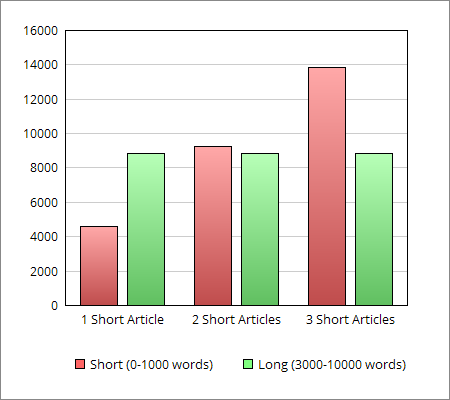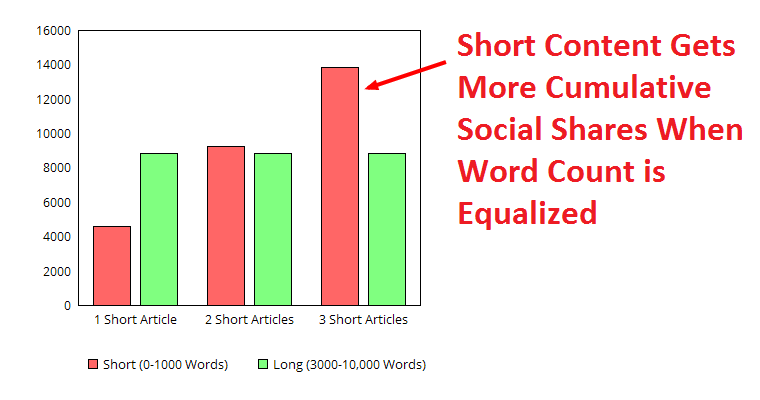There’s a ton of free information about online marketing. But despite all the free info out there, many people are still struggling and failing with content marketing.
Digital marketing bloggers have put out a good amount of research and I like that people are willing to share their data and insights.
Data can be useful.
But sometimes people draw conclusions too quickly from data. In marketing, there are few absolute truths and sometimes it’s wise to look for exceptions. Spending the time to write long-form content is a common piece of advice among digital marketing bloggers, but in this article, I take a closer look at how some influencers and high traffic blogs grew to over 100,000 subscribers by doing the opposite.
1. Syndication
Short articles can sometimes be syndicated for additional exposure and it’s arguably one of the best reasons to consider a short form content strategy. Many media sites that syndicate content have short articles that can be read in a few minutes and wouldn’t syndicate a 5,000-word ultimate guide, for example.
James Clear has done really well as a self-improvement and productivity blogger. Many of his articles are fairly short, sometimes less than 1,000 words. But syndicating his articles to high traffic sites has allowed him to greatly amplify the reach of his articles and grow his blog to over 200,000 subscribers.
Plenty of studies show long form content gets more traffic, social shares, and engagement than short form content. But those studies don’t take into account the effects of syndication on amplifying content reach.
I did an analysis of Jamesclear.com and found 59 articles that were also syndicated to Business Insider. These articles averaged 5,070 social shares on his site and 3,490 on Business Insider. That means that James was able to increase social shares by 69% simply by syndicating to one site.
And James also syndicates to a bunch of other sites too, including Lifehacker and Entrepreneur.
With syndication, a quality short article can actually outperform a similar long-form blog post. In other words, a short article that took less time to write could actually end up getting more traffic, views, and social shares when you count the additional exposure it received through syndication.
2. Time
Most studies don’t take content creation time into account. Meaning, you can often create multiple short articles in the time it takes to create a long article, so counting the shares of a single piece of short-form content to a single piece of long-form content might not be accurate. Every time I publish a new piece of content, I get a bump in traffic from my subscribers coming to read the new post. The articles often get shared on social media, which sends more traffic.
And some articles send me ongoing search engine traffic.
However, quality long form content takes a lot of time to research and write. People also tend to spend more time promoting long-form content since it took so much time to create. Hubspot published a study showing blogs that publish more frequently tend to get more traffic.
| Monthly Blog Posts | Indexed Traffic |
| 0-2 | 100 |
| 5-10 | 140 |
| 16+ | 350 |
So, since we need to publish consistently and regularly to get the best results, sometimes we have to trade off between time and “quality”. Unfortunately, if we want to publish regularly, most people simply don’t have time to create an ultimate guide every week.
BuzzSumo published a study that showed long form content tended to get more social shares on Noah Kagan’s blog. According to Buzzsumo’s data, long articles (3,000-10,000 words) got an average of 8,859 social shares per article and short articles (0-1,000 words) got an estimated 4,615 social share per article.
I do enjoy studies like these because it’s encouraging when I’m putting the time into writing a long form blog post or guide. However, studies like these don’t take into account that it takes less time to write a short blog post.
Which would take you longer to write? Two 1,000 word blog posts or a 3,000-word blog post? I think most writers would say two 1,000 word blog posts, especially since it’s fewer words than one 3,000 word blog post.
So could two or three shorter blog posts outperform one really long blog post?

Data Source: Why Content Goes Viral – What Analyzing 100 Million Articles Taught Us
When you compare two short articles to one long article, the two short articles cumulatively get slightly more social shares, i.e., more total shares with fewer words written.
When you compare the average cumulative social shares from three short 1,000-word articles to a long 3,000-word article, it becomes clear that a series of shorter articles outperforms one longer article on average in terms of social sharing.
Now all of the sudden, short form content doesn’t look so bad, does it?
3. Expense
If you’re a marketing manager or business owner, then perhaps you have to pay other people to create content. Long content can be really expensive, perhaps even prohibitively expensive for some businesses. Some of the longest posts on my blog took weeks to write. Perhaps longer if you count the time I took to update them.
According to Payscale, the average content marketer makes $61,000 a year and a really good content marketer will cost even more. That means that a really long blog post or ultimate guide could end up costing thousands of dollars, just for that one piece of content.
And, since we need to create content on an ongoing basis, it also becomes an ongoing cost.
Companies do need to invest money into creating high-quality content, but they should be careful about how they use their resources. While some companies insist on minimum length requirements for their content, content managers should reconsider the possibility of incorporating a short content strategy.
4. Readership
There is a good reason why some blogs and media sites have stuck with a short content strategy, despite all the research about longer content getting more search engine traffic and social shares. A study by Neilson Norman group shows people prefer and are more likely to read shorter content. And a separate study by Demand Gen Group shows 95% of B2B buyers prefer short content over long content.
According to an article in Psychology Today, people only read 60% of an online article on average. And an article in Time magazine stated 55% of readers stay less than 15 seconds on a web page.
People are very busy and have low attention spans when surfing the web. So short content may not be a bad thing if you want to maintain a high reading rate.
5. Long Doesn’t Necessarily Equal More Traffic
Longer doesn’t necessarily mean better quality or more traffic. I’ve seen plenty of people attempt long form content that didn’t do well.
Dale Cudmore talked about his experience with creating a Definitive Guide to Writing Resumes. He spent a good amount of time to make the design and content stand out from the articles that were currently ranking in Google.
Although he felt like it was better than other articles currently ranking and he promoted it via email outreach, he was unable to even get on the first page of Google for his target keyword. It’s not to say that his content wasn’t high quality, but since there were already similar guides, his guide wasn’t really groundbreaking.
Dale is not alone in his experience. I’ve discovered plenty of long content that didn’t do well. Short content allows you to test ideas faster and with fewer resources before you invest in long content.
To Wrap it Up
The point of this article isn’t to conclude that short content is better than long content or vice versa. They’re just different and both can be very effective.
In fact, long content can bring in a good amount of long tail SEO traffic and can also be easier to promote. But as a content marketer, it would be unwise to ignore the possibility of using short content without giving it more thorough consideration.
A short content strategy can work really well if it is well conceived. And a long form content strategy can also work well. And sometimes people will write content that falls somewhere in the middle.
Evaluate the pros and cons of all possibilities carefully when devising your content strategy.
If you want to get the best of both worlds, consider testing out a hybrid strategy. Regardless of what research studies suggest, some people will respond to short content while others won’t mind taking the time to read longer articles.
Having a mix of both could allow you to get the best of both worlds or, at least, test out what format works best for your audience. In fact, the Neilsen study I mentioned earlier suggested that a content strategy that mixes both short and long content formats may be optimal as it appeals to both readers who want a quick read and those that have the appetite for more in-depth articles.
Short content can work really well, but that doesn’t mean you shouldn’t put time into your content. You need to create articles your audience will find valuable.
To date, the most shared article on my own blog is my LinkedIn publishing study, which has over 5,000 social shares.

Even though it’s only around 1,000 words long, it still took a good amount of time to conduct the study. Since LinkedIn publishing was still in beta access at the time and there wasn’t much information on the platform, the article did really well.
While research studies and experiments can provide useful information, it’s important to draw the right conclusions from the data. Influencers don’t obsess over averages and sometimes going against the trend is a better way to stand out.
Don’t be average, be the exception.
I’ve done plenty of long content myself and I don’t intend to stop creating long content. But I do plan on adding more short content into the mix.
What do you think? Do you use short form content or have you blown it off? Have content marketers discredited short form content too soon?
Image Credits
Featured Image: Graph by Brian Lang. Created with Chart Go
In-post Photo: Graph by Brian Lang. Created with Chart Go
Screenshot taken by Brian Lang, February 2016.





